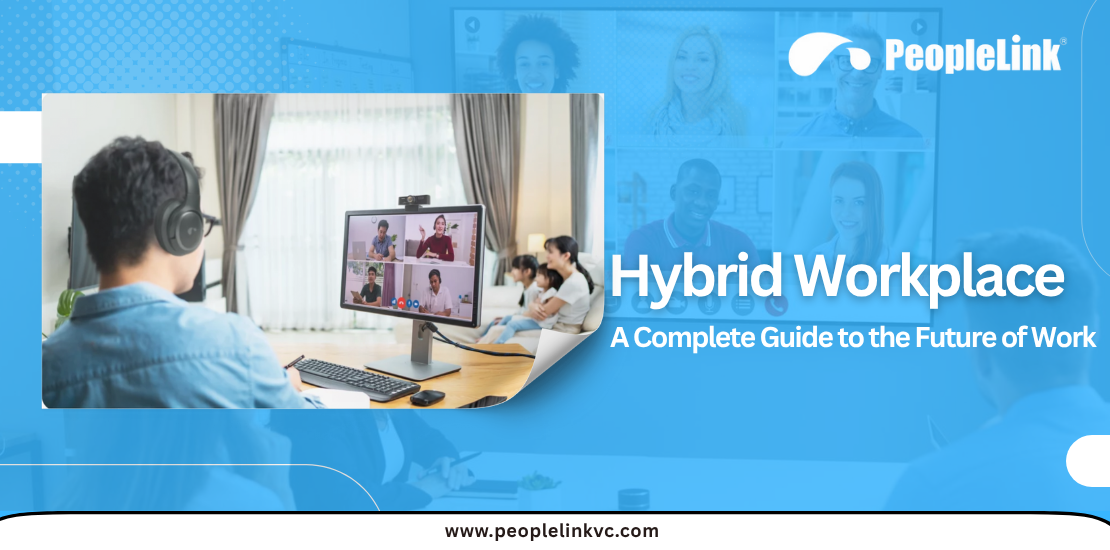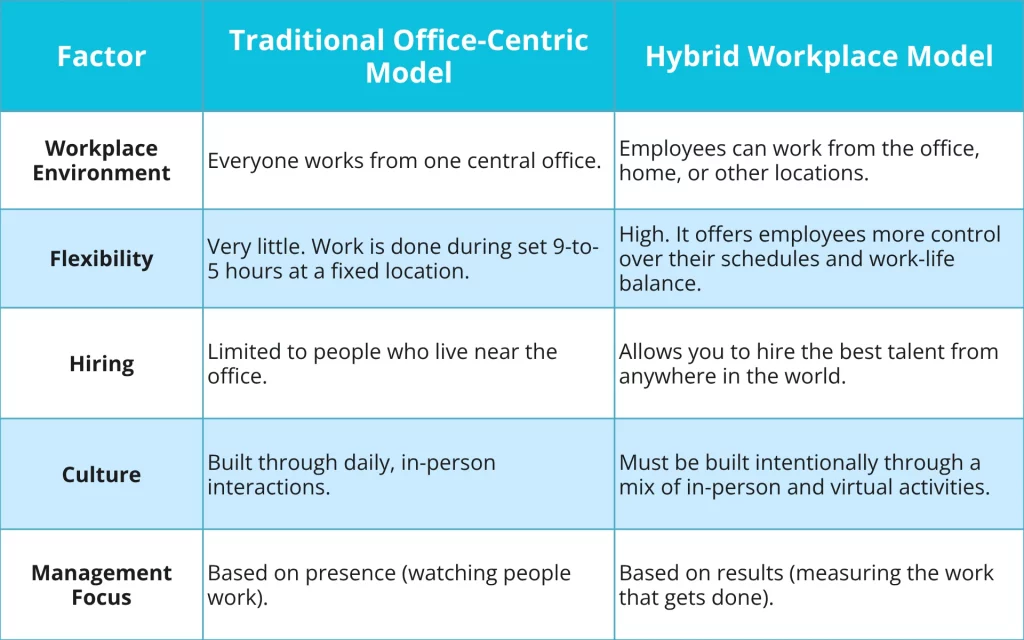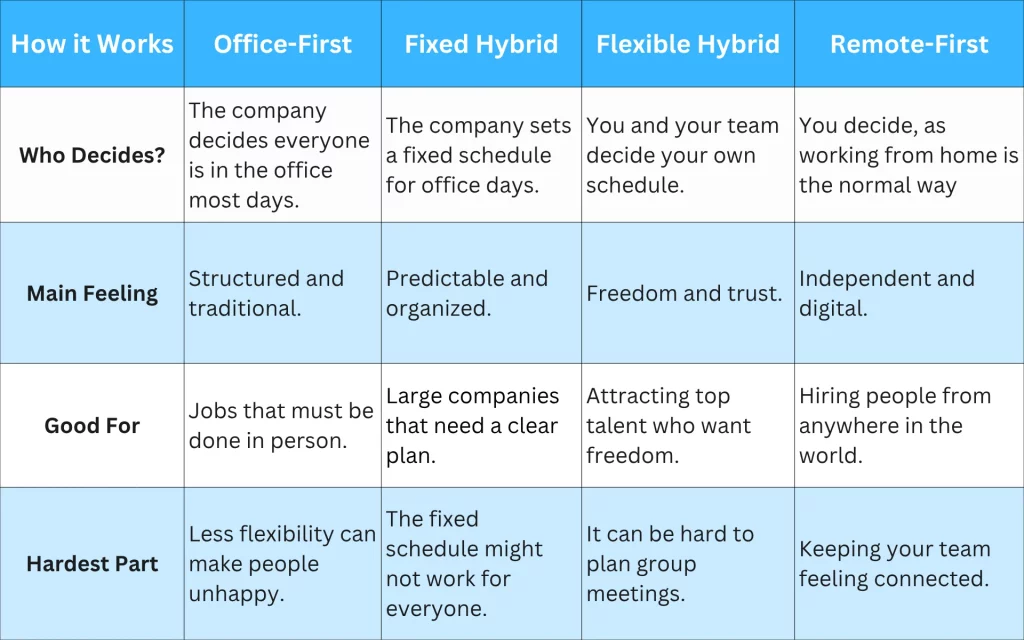The Hybrid Workplace Explained: A Complete Guide to the Future of Work
- October 14, 2025
- Posted by: PeopleLink
- Category: Blogs

A hybrid workplace is a flexible model that mixes time in the office with remote work, completely changing the purpose of your physical office and the tools needed to connect your team. Understanding the hybrid workplace is more important than ever — it’s a permanent change in how we work, hire, and build company culture.
In this guide, we’ll give you a complete and simple overview of the topic. We’ll explain why it’s a major trend, show you the different hybrid work models, discuss how to redesign your office, and look at what’s next for the future of work. Use this guide to get the clear answers you need to plan for what’s ahead.
What is a Hybrid Workplace Model?
You have probably heard the term hybrid workplace or hybrid working a lot lately. But what does it mean for you and your business?
At its core, a hybrid workplace is a flexible model that mixes in-office work with remote work, giving you and your team the freedom to choose where and how you work best. This is a big change from the traditional office-centric model, where everyone is required to work from a central office during set hours, every day.
When you compare, you will see the real difference isn’t just about location, but it’s a fundamental shift in how we approach work itself.
A simple table is the easiest way to see how these two models compare.

What are the Different Types of Hybrid Models?
Most hybrid strategies fall into one of four main categories, each offering a different balance of flexibility and structure.
- Office-First: In this model, the office is still the main place of work. Your team is expected to be in the office most of the week but can work from home on the other days.
- Fixed Hybrid: in this model, company sets the schedule for in-office and remote days, not the employee.
- Flexible Hybrid: In a flexible hybrid model, the decision of when to come into the office is usually left to the individual employee or their team leader.
- Remote-First: In this model, working from home is the default for everyone. The physical office is not for daily work but is used as an optional resource for special events like team get-togethers or project kick-offs.
Here is a simple comparison to illustrate the difference:

3 Types of Technologies You Need to Make a Hybrid Model Work
In a hybrid workplace environment, your goal is to create one unified experience for everyone, no matter where they are. This is not going to happen if you don’t have these three core technologies set up in your workplace:
1. The Right AV Hardware:
The first fundamental technology you need for connecting in-office and remote employees is the right set of AV hardware solutions. This includes everything that makes fundamental video conferencing work.
However, the most critical thing you need to understand when choosing hardware for a hybrid work environment is that not all hardware is created equal. The problem is that standard hardware like a simple webcam or a basic conference phone was never designed to handle the complex mechanics of a hybrid meeting. If you use these older technologies, it will create nothing more but a frustrating and unfair experience for remote participants.
To make a hybrid model work, you need hardware that is specifically built for it. Here is what to look for:
- Intelligent Camera Devices: You need a more advanced camera than a simple webcam. You need a camera devices that comes with features like AI Speaker Tracking and Auto group framing. These intelligent features will help automate your meetings and create an equal experience for everyone. You can explore our range of Conferencing cameras and video bars that are designed with these exact features to solve the challenges of a hybrid meeting.
- Smart Audio Systems: Forget about using typical microphone and speakers in this new AI era. To succeed in the hybrid era really, you need better and more advanced microphones and speakers. You need audio devices that comes with built-in intelligence like noise suppression and echo cancellation. These technologies are designed to distinguish human speech from background noise like keyboard typing or air conditioning. You can find these capabilities across our portfolio of smart audio systems, which includes all-in-one devices, dedicated microphones, and audio processors.
2. The Right Software
The second technology component you need is the virtual collaboration software. You need such software because this is going to be an online hub where your entire hybrid team connects, communicates, and collaborates, no matter where they are. Without it, your company culture becomes fragmented, and information gets lost.
To make a hybrid model work, you need these specific types of software:
- Unified Communication and Collaboration Platforms: You need these platforms to unify different features like instant messaging, video conferencing, and file sharing into one place so that it is easier for everyone in your hybrid team work together.
- Cloud-Based Systems and Document Collaboration: These cloud-based systems ensure all documents and data are accessible 24/7 from any device, which makes the experience of working together externally smooth.
- Project Management Software: In a hybrid environment, your team won’t always be working at the same time. Such software provides a place to see who is doing what, tracking tasks, deadlines, and progress.
3. The Right Infrastructure
The third and final technology component you need is the right infrastructure. Without a solid infrastructure, even the best hardware and software will fail. For a hybrid environment, your infrastructure must be strong in two critical areas:
- High-Speed, Reliable Internet: Your office network must be powerful enough to handle many high-quality video calls at once without lag or poor quality.
- Strong Cybersecurity: A hybrid model creates more security risks because your employees are connecting from many different networks and devices. To protect your company’s data, you must build your infrastructure on a modern “zero-trust” security approach. This simply means your system doesn’t automatically trust any user or device and requires verification for every request to access information.
3 Ways You Can Get Started with Hybrid Work Model Instantly
1. Start with a Simple Survey
You can’t build a model that works for your people without knowing what they actually want. Before you make any decisions, the first and most important step is to ask your team for their input.
This doesn’t need to be a long, complicated survey. Just ask them a few simple questions:
- How many days a week would they prefer to be in the office?
- What are their biggest frustrations with remote meetings right now?
- What would make the commute to the office feel “worth it” for them?
The answers you get will be the foundation for your entire plan. They will give you the clear data you need to start building a model that your team will actually support and use.
2. Launch a Pilot Program
You don’t have to change your whole company overnight. The smart way to start is to run a small-scale pilot program. This is a low-risk way to learn what works for your specific company hybrid work culture before you roll it out to everyone.
Choose one team or department and try out a simple hybrid model. Let them try it for a few months, then gather feedback on what worked and what didn’t. This will give you the real-world experience you need to create a policy that is practical and effective for your entire organization.
This tailored approach means we can find the perfect solution that fits your needs and your budget, ensuring you get it right the first time.
3. Partner with an End-to-End AV Solution Provider
Once you start your pilot program, you will quickly discover that the hardest part of making a hybrid model work is the technology that connects everyone. This is where partnering with an expert can be the fastest, easiest, and most accurate way to build your hybrid workplace.
Instead of trying to figure out which cameras, microphones, and software to buy, you can work with a partner who understands how to create a complete, integrated solution. Partnering with an end-to-end provider takes all the guesswork out of the process.
Take PeopleLink, for example. For over 18 years, we have helped organizations design successful hybrid workplaces. Our approach is a simple, consultative process where we treat each customer as a unique case. We start by listening to your specific needs and then design a complete system that is built for your team, your space, and your budget.
It does not matter if you need a hybrid workplace setup for a 3-6 PAX huddle room, a 6-8 PAX meeting room, or a 12-15 PAX conference room; we have pre-configured solution bundles designed for every space and need. Having these options means we can find the perfect solution that fits your needs and your budget, ensuring you get it right the first time.
3 Challenges You Will Face When Going Hybrid First Time
When you are going to move to hybrid model, there are 3 basic challenges that you will face. If you don’t manage these challenges from the start, they can cancel out all the advantages you are trying to achieve.
- The Proximity Bias Trap: One of the biggest risks you will face is something called proximity bias. This is the natural tendency for managers to favor employees who are physically in the office over those who are working remotely. This “WFH promotion penalty” is a huge risk for your company, as it can undo years of progress in building a diverse and inclusive team.
- The Engagement-Wellbeing Puzzle: While the freedom of a hybrid model often makes your employees more engaged in their jobs, it can also make them less happy in their overall lives if not managed well. This means you can’t just let your team work from home and assume they will be happy. You must intentionally plan for connection.
- The Flexibility cost: Many companies see hybrid work only as a way to cut costs. But they don’t know is that the money you save from reducing your office space don’t go straight to your bottom line. You must reinvest the saved money back into three key areas: Technology, training employees, and building a strong culture.
Why the Hybrid Workplace is Trending Now
There are three powerful forces that are making the hybrid model booming so much in the business world:
- First, the world went through a massive remote work test. This proved to companies everywhere that for many jobs, work is something you do, not a place you go. It showed that people could be just as productive, if not more, outside of a traditional office.
- Second, employees are demanding it. After experiencing the benefits of more freedom and a better work-life balance, most people don’t want to go back to the old way.
- Finally, this demand for job flexibility has become a major competitive advantage for companies. In a tough job market, offering a hybrid model allows you to attract the best talent from anywhere in the world, not just from your local area.
How Does the Hybrid Work Model Affect the Organization?
When you move to a hybrid work model, it fundamentally reshapes your entire organization. It forces you to rethink almost every part of your business.
The single biggest change that you will notice is that the physical office is no longer the main place for all work. It stops being the default place for individuals to work and becomes a purposeful destination for planned employee engagement activities like team collaboration, brainstorming, and building company culture.
This change means you can no longer manage your team just by seeing them at their desks. Instead, you have to manage them by measuring outcomes. This requires you to rebuild your culture on a foundation of trust and clear results.
Simultaneously, this hybrid model of working breaks all the old habits. You will find that old, in-person ways of getting work done quickly become roadblocks, which forces you to upgrade to digital, location-independent processes. While this is a complex change, it brings powerful benefits. It allows you to hire the best people from anywhere in the world and save money on office space.
Ultimately, the hybrid model means you are building a unbreakable business that can sustain itself in good and crises situations.
How is the Hybrid Work Model Affecting the employee Engagement and well-being?
The hybrid model has a surprising effect on your employees. You might think that less time in the office means less focus on work, but workforce data consistently shows the opposite is true.
A surprising benefit of this model is higher engagement in the workplace; hybrid and remote employees are often much more engaged in their jobs than those who are always in the office.
This happens because the model gives them more freedom, flexibility, and control over how they get their work done. When you trust your people to manage their own time, they often become more connected and enthusiastic about their job.
But it creates problems too.
Even though remote employees are highly engaged in their jobs, they often report more daily stress and loneliness than their coworkers who come into the office sometimes.
This is where the hybrid model truly shines. It offers the perfect solution to this puzzle. The data strongly suggests that the hybrid model is the “sweet spot”. By balancing freedom with planned opportunities for your team to connect, you create a workplace where your employees are not only more engaged in their work but also happier in their lives.
Your Next Step: Building Your Future of Work
Remember, the move to hybrid is more than just a new policy. it is a fundamental change to your business strategy. To get successful at this, you must approach your new workplace model intentionally. You must have a clear plan to manage the new complexities while reaping the incredible benefits of this remote and hybrid work model such as improved workforce engagement and talent retention.
Build Your Hybrid Workplace Environment with PeopleLink Today
If want to build a successful hybrid workplace for your hybrid team, we can help you build one. To start the conversation, you can contact our team in several ways:
- Website: Fill out the contact form on our official PeopleLink website.
- Email: Send your questions directly to our solutions team at vc@peoplelinkvc.com.
- Phone: Call our expert team directly at +91-91001 23013
FAQ's
What is a hybrid workplace?
A hybrid workplace is a flexible work model that mixes in-office work with remote work, giving you and your team the freedom to choose where and how you work best.
What is the difference between hybrid and remote work?
The main difference is that a hybrid model is a mix of in-office and remote work where a physical office still plays a key role. In a fully remote model, there is no central office, and all work is done outside of it.
What does hybrid mean with a job?
For your job, hybrid means you have the flexibility to split your work time between the company office and working remotely from another location. This model gives you more freedom to balance your work and personal life.
Why is hybrid work better?
Hybrid work is often considered better because it offers a “sweet spot” between job engagement and employee well-being. You get the flexibility of remote work while still having the in-person connection of the office, which helps companies attract and keep top talent.
How does a hybrid system work?
A hybrid system works based on a company policy that sets the rules for how you split time between the office and remote locations. Some models are very flexible, letting you choose your schedule, while others have a fixed schedule with set days for everyone to be in the office.


